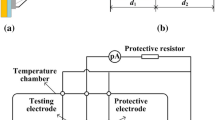Abstract
Moisture in the insulation of distribution cable accessories is one of the important causes of insulation degradation and discharge failure of the accessories. The changes in the insulation properties of ethylene-propylene-diene monomer (EPDM) and silicone rubber (SIR) with the time of dampness are studied, and the mechanism of dampness is revealed by combining the surface water absorption characteristics and functional group analysis. The results show that the hydrophobicity of EPDM specimens is lower than that of SIR, resulting in the electrical properties of EPDM being significantly lower than those of SIR after water immersion. The resistivity and the flashover voltage of both specimens decrease significantly with the increase of moisture exposure time, and the decrease of EPDM is more obvious than that of SIR. The breakdown voltage of EPDM decreases by 26.6% and that of SIR decreased by 13.06%. Besides, the flashover voltage along the surface of both EPDM and SIR decreases with the increase of water immersion time, and the decreasing trend of both of them is basically the same. This work has guiding significance for the material selection of the cable accessories and the analysis of damp failure.










Similar content being viewed by others
References
Fynes-Clinton D, Nyamupangedengu C (2016) Partial discharge characterization of cross-linked polyethylene medium voltage power cable termination defects at very low frequency (0.1 Hz) and power frequency test voltages. IEEE Electr Insul Mag 32(4):15–23
Raicevic NB et al (2015) Reducing the impact of ELF electromagnetic fields of HV power cables on the environment by modeling the cable accessories. COMPEL 34:1016–1028
Stojanović M, Klimenta J, Panić M et al (2023) Thermal aging management of underground power cables in electricity distribution networks: a FEM-based Arrhenius analysis of the hot spot effect. Electr Eng 105:647–662. https://doi.org/10.1007/s00202-022-01689-z
Paunović IŽ (2023) Expressions for the earth resistance of the human feet in safety studies of earthing systems. Electr Eng 105:1377–1396. https://doi.org/10.1007/s00202-023-01736-3
Cai L, Yan G, Lin J (2023) Lifetime prediction of ship EPR cable under two factors based on retention rate of hardness. Electr Eng 105:1839–1848. https://doi.org/10.1007/s00202-023-01748-z
Thomas AJ, Saha TK (2008) A new dielectric response model for water tree degraded XLPE insulation—part A: model development with small sample verification. IEEE Trans Dielectr Electr Insul 15(4):1131–1143
Joneidi IA, Kamarposhti MA, Shayegani Akmal AA et al (2013) Leakage current analysis, FFT calculation and electric field distribution under water droplet on polluted silicon rubber insulator. Electr Eng 95:315–323. https://doi.org/10.1007/s00202-012-0260-8
Kemaloglu S, Ozkoc G, Aytac A (2010) Properties of thermally conductive micro and nano size boron nitride reinforced silicon rubber composites. Thermochim Acta 499(1):40–47
Jahromi AN, et al (2006) Accelerated acid-water aging of RTV silicone rubber coatings. In: IEEE conference on electrical insulation & dielectric phenomena. IEEE
Gorur RS, Johnson LA, Hervig HC (1991) Contamination performance of silicone rubber cable terminations. IEEE Trans Power Deliv 6(4):1366–1373. https://doi.org/10.1109/61.97665
Kamiya Y, Muramoto Y, Shimizu N (2007) Effect of gas impregnation in silicone rubber on electrical tree initiation. In: Electrical insulation and dielectric phenomena, 2007. CEIDP 2007. Annual report—conference on IEEE, 2007
Bouguedad D et al (2016) Physico-chemical study of thermally aged EPDM used in power cables insulation. IEEE Trans Dielectr Electr Insul 22(6):3207–3215
Sarac T, Devaux J, Quievy N, Gusarov A, Konstantinovic MJ (2017) The correlation between elongation at break and thermal decomposition of aged EPDM cable polymer. Radiat Phys Chem 132:8–12
Florkowska B et al (2013) Interaction of conductor with polymeric materials (XLPE/EPR) at partial discharges. IEEE Trans Dielectr Electr Insul 19(6):2119–2127
Standard conditions for use prior to and during the testing of solid electrical insulating materials (Endorsed by AENOR in October of 2011.).UNE-EN 60212-2011.2011
Mansour D et al (2020) Recent advances in polymer nanocomposites based on polyethylene and polyvinylchloride for power cables. Materials 14(1):66
Saidj IB et al (2022) Effects of hydrothermal aging on the breakdown voltage of polyesterimide. Ann Chim Sci Mater 2:46
Li ZW et al (2018) Research on water content and physicochemical properties of insulating materials for water-soaked XLPE cable. Mater Sci Forum 922:192–197
Ye Y et al (2014) Study about insulating properties of 10 kV XLPE damp cable. Power Syst Technol 38:2875–2880
Li G et al (2023) The lifetime prediction and insulation failure mechanism of XLPE for high-voltage cable. IEEE Trans Dielectr Electr Insul 30(2):761–768
Sekii Y, Asakawa K, Mouri K (2001) Statistical investigation of dielectric breakdown of LDPE. In: International symposium on electrical insulating materials. IEEE
Fothergill JC (1991) Filamentary electromechanical breakdown. IEEE Trans Electr Insul 26(6):1124–1129
Zhang J, et al (2022) Study on drying performance of high voltage cable buffer layer material. In: Proceedings of 2022 2nd international conference on advanced energy, power and electrical engineering (AEPEE2022). EDP Sciences, pp 15–22
Acknowledgements
This work was supported by the National Natural Science Foundation of China (Grant No. 52107154). Youth Innovation Technology Support Plan of Shandong Province universities (Grant No. 2021KJ023).
Author information
Authors and Affiliations
Contributions
WS did investigation, experiments, and analysis. KG done data curation. WL was involved in IR experiment. GL and YW investigated the study. XL contributed to conceptualization, investigation, and review. YN performed conceptualization.
Corresponding author
Ethics declarations
Conflict of interest
The authors hereby declare that they have no competing interests as defined by Springer or other interests that might be perceived to influence the results and/or discussion reported in this paper.
Additional information
Publisher's Note
Springer Nature remains neutral with regard to jurisdictional claims in published maps and institutional affiliations.
Rights and permissions
Springer Nature or its licensor (e.g. a society or other partner) holds exclusive rights to this article under a publishing agreement with the author(s) or other rightsholder(s); author self-archiving of the accepted manuscript version of this article is solely governed by the terms of such publishing agreement and applicable law.
About this article
Cite this article
Sun, W., Guo, K., Luo, W. et al. Comparison of EPDM/SIR insulation performance and mechanism analysis of the distribution cable accessories under moisture condition. Electr Eng 106, 31–39 (2024). https://doi.org/10.1007/s00202-023-01960-x
Received:
Accepted:
Published:
Issue Date:
DOI: https://doi.org/10.1007/s00202-023-01960-x




